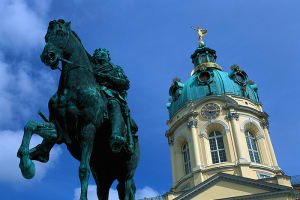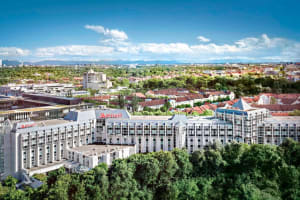Germany Vacations & Travel
Germany Vacations
Germany wears its riches well: elegant big-city charm, small picture-postcard towns, pagan-inspired harvest festivals, a wealth of art and culture and the perennial pleasures of huge tracts of forest, delightful castles and fine wine and beer are all there for the savoring.
Region: Europe
Germany Destinations:
Featured Germany Hotel
-
See All Germany HotelsBook Now
Munich Marriott Hotel
Munich, GermanyOur 4-Star classification designates those properties with well-appointed, deluxe accommodations, extensive amenities and comprehensive guest services. Expect attention to detail and a warm and hospitable staff ready to cater to your needs. These superb properties offer a truly refined getaway.-
 Breakfast Not Included
Breakfast Not Included -
 No Spa Services
No Spa Services -
 No Meal Plans Available
No Meal Plans Available -
 No Villa
No Villa -
 No Honeymoon Amenity
No Honeymoon Amenity -
 Charge for Wi-Fi
Charge for Wi-Fi -
 Elevator(s)
Elevator(s) -
 Gym/Fitness Center
Gym/Fitness Center -
 Non-Smoking Property
Non-Smoking Property -
 Air Conditioning
Air Conditioning
This revered hotel featuring timeless design is family friendly. It's the perfect place to experience the Bavarian lifestyle.
-
What To See
Aachener Dom
It’s impossible to overestimate the significance of Aachen’s magnificent cathedral. The burial place of Charlemagne, it’s where more than 30 German kings were crowned and where pilgrims have flocked since the 12th century.
The oldest and most impressive section is Charlemagne’s palace chapel, the Pfalzkapelle, an outstanding example of Carolingian architecture. Completed in 800, the year of the emperor’s coronation, it’s an octagonal dome encircled by a 16-sided ambulatory supported by antique Italian pillars. The colossal brass chandelier was a gift from Emperor Friedrich Barbarossa during whose reign Charlemagne was canonized in 1165. Pilgrims have poured into town ever since that time, drawn in as much by the cult surrounding Charlemagne as by his prized relics: Christ’s loincloth when he was crucified, Mary's cloak, the clothes used for John the Baptist when he was beheaded and swaddling clothes from when Jesus was an infant. These are displayed once every seven years (next in 2014) and draw 100,000 or more faithful.
To accommodate these regular floods of the faithful, a Gothic choir was docked to the chapel in 1414 and filled with such priceless treasures as the pala d’oro, a gold-plated altar-front depicting Christ’s Passion, and the jewel-encrusted gilded copper pulpit, both fashioned in the 11th century. At the far end is the gilded shrine of Charlemagne that has held the emperor’s remains since 1215. In front, the equally fanciful shrine of St Mary shelters the cathedral’s four prized relics.
Unless you join a guided tour, you’ll barely catch a glimpse of Charlemagne’s white marble imperial throne in the upstairs gallery. Reached via six steps – just like King Solomon’s throne – it served as the coronation throne of those 30 German kings between 936 and 1531. The tours themselves are fascinating for the level of detail they reveal about the church. Before entering the church, stop by the new Dom Visitors Centre for info and tickets for tours and the Schatzkammer.
Schloss Neuschwanstein
Appearing through the mountaintops like a misty mirage is the world’s most famous castle, and the model for Disney’s citadel, fairy-tale Schloss Neuschwanstein.
King Ludwig II planned this castle himself, with the help of a stage designer rather than an architect, and it provides a fascinating glimpse into the king’s state of mind. Built as a romantic medieval castle, work started in 1869 and, like so many of Ludwig’s grand schemes, was never finished. For all the coffer-emptying sums spent on it, the king spent just over 170 days in residence.
Ludwig foresaw his showpiece palace as a giant stage on which to recreate the world of Germanic mythology in the operatic works of Richard Wagner. Its epicenter is the lavish Sängersaal (Minstrels’ Hall), created to feed the king’s obsession with Wagner and medieval knights. Wall frescos in the hall depict scenes from the opera Tannhäuser. Concerts are held here every September.
Other completed sections include Ludwig’s Tristan and Isolde–themed bedroom, dominated by a huge Gothic-style bed crowned with intricately carved cathedral-like spires; a gaudy artificial grotto (another allusion to Tannhäuser); and the Byzantine Thronsaal (Throne Room) with an incredible mosaic floor containing over two million stones. The painting on the wall opposite the (throneless) throne platform depicts another castle dreamed up by Ludwig that was never built. Almost every window provides tour-halting views across the plain below.
At the end of the tour visitors are treated to a 20-minute film on the castle and its creator, and there's a reasonably priced cafe and the inevitable gift shops.For the postcard view of Neuschwanstein and the plains beyond, walk 10 minutes up to Marienbrücke (Mary’s Bridge), which spans the spectacular Pöllat Gorge over a waterfall just above the castle. It’s said Ludwig liked to come here after dark to watch the candlelight radiating from the Sängersaal.
Brandenburger Tor & Pariser Platz
A symbol of division during the Cold War, the landmark Brandenburg Gate (Brandenburger Tor) now epitomizes German reunification and often serves as a photogenic backdrop for festivals, concerts and New Year Eve' parties. Carl Gotthard Langhans found inspiration in the Acropolis in Athens for the elegant triumphal arch, completed in 1791 as the royal city gate. It is crowned by the Quadriga, Johann Gottfried Schadow's sculpture of the winged goddess of victory piloting a chariot drawn by four horses. After trouncing Prussia in 1806, Napoleon kidnapped the lady and held her hostage in Paris until she was freed by a gallant Prussian general in 1815.The Brandenburg Gate stands sentinel over Pariser Platz, a harmoniously proportioned square once again framed by banks as well as the US, British and French embassies, just as it was during its 19th-century heyday.
Events
Germans love to party, and kick up their heels at everything from pagan harvest romps to black tie opera galas. The Winter Carnival (Fasching) season occurs throughout Germany, with big cities such as Cologne (Köln), Munich and Mainz erupting into commotion just before Ash Wednesday.
Germany's rich musical heritage is showcased in a plethora of festivals. Some towns concentrate on a particular composer, such as the Thuringian Bach Festival in Erfurt in March or the Richard Wagner Festival in Bayreuth each July, whereas others focus on a particular style. The jazz festivals in Stuttgart (July) and Berlin (early November) are lively and popular.
Autumn is a great time for harvest-inspired mayhem, especially in the Rhineland, where the five Rhine in Flames extravaganzas feature barges laden with fireworks. Mention must be made of Oktoberfest, Munich's annual lager frenzy, but it's a bit like being stuck in an endless soccer crowd and is more an example of mass tourism catering to the lowest liquid denominator than a display of German culture. Christmas markets, with their twinkling lights and steaming mulled wine (Glüwein) are embraced wholeheartedly by German families; they occur in Frankfurt, Munich, Nuremberg, Lübeck, Berlin, Münster, Heidelberg, Rüdesheim and Stuttgart, amongst other places.
Entry Requirements
Most EU citizens only need their national identity card or passport to enter, stay and work in Germany. Americans, Australians, Canadians, New Zealanders, Poles, Swiss, Japanese and Israelis just need a valid passport (no visa) to enter Germany as tourists. Passports should be valid for at least another four months from the planned date of departure from Germany.
Nationals from most other countries need a so-called Schengen visa. Applications for this visa must be filed with the embassy or consulate of the country that is your primary destination in Europe. It is valid for up to 90 days.
Please contact the German consulate for up-to-date information on travel document requirements.




